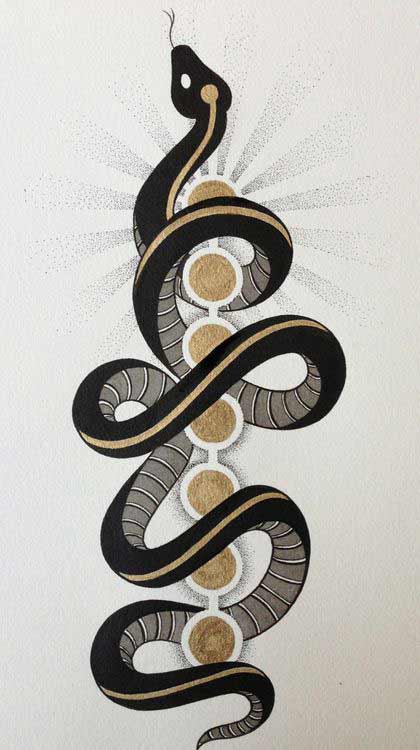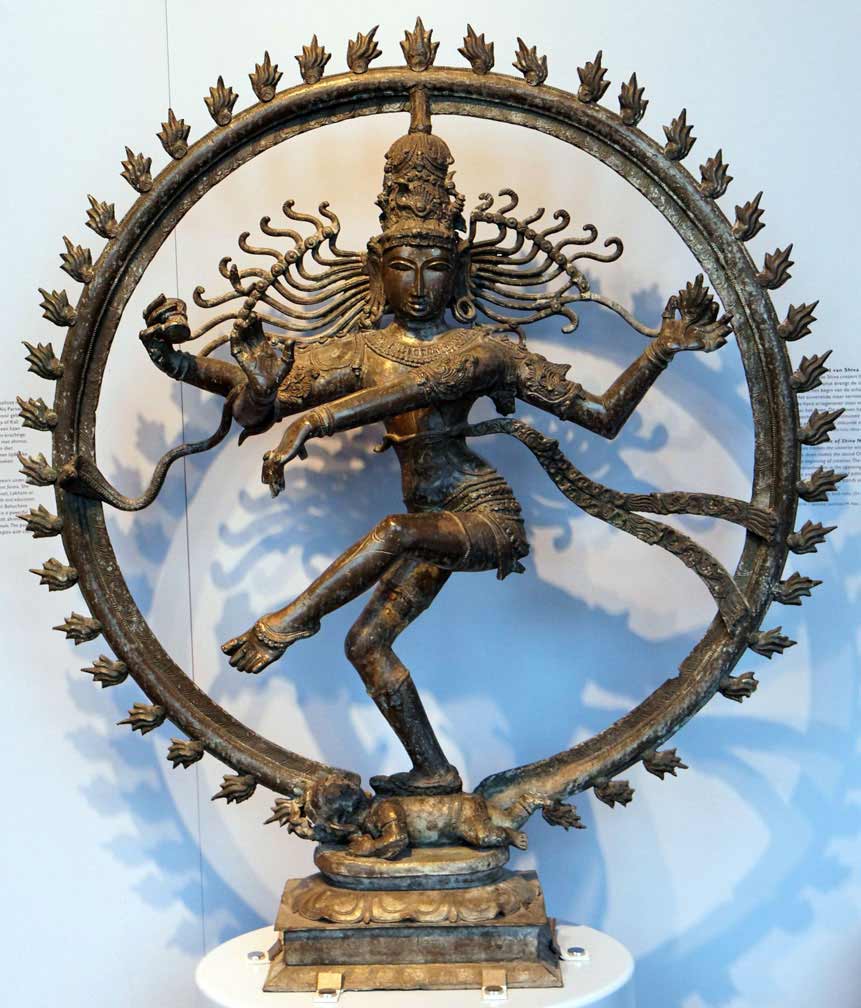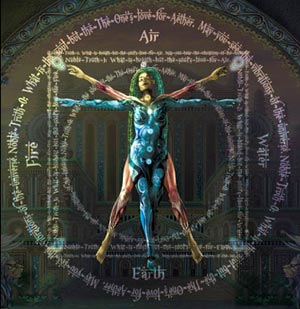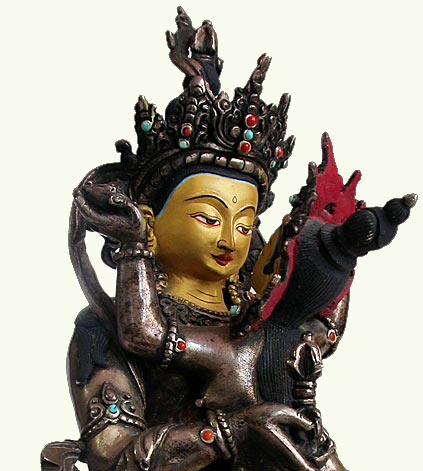Sex is perhaps the most problematic of all human activities. The sex drive is a powerful, natural and necessary force of nature: it creates sexual appetite
as a matter of course. It cannot be healthily denied. Rather, it must be embraced and navigated consciously. Yet so deep is it in us that it is not easy to
recognise and express its simple, natural place in the overwhelming complexity of our modern lives. Few of us are not suffering the consequences of
powerful, and often destructive, cultural forces of sexual conditioning. Few understand the sexual forces that move us. Fewer still integrate them with
enrichment into their lives. Nevertheless by becoming sensitive to the depths and subtleties of natural intelligence the most honest and authentic
expression of our sexual nature can and will be found.
Sex and yoga are inextricable. Yoga can easily be understood as a process of establishing harmony between the divergent impulses and energies within. It is
often understood to involve or require the transformation of sexual into spiritual energy. Even when this is so, it cannot be based on denying nor
repressing sexual energy, for it is the basis, the source of human life. To become truly comfortable in life, we must enjoy an open, honest sexuality. The
more truly at peace we are with life, the less this will resemble the compulsive, habituated patterns of sexual behaviour to which we have been culturally
conditioned.
Yoga posture practitioners are constantly faced by the cultural divide between body and mind. Moment by moment, breath by breath we must choose, even if
unconsciously, to follow body or mind. Yet they are not always in harmony. While yoga posture practice can help them to be, it can easily become a way to
extend the division that culture has placed between them. This depends on whether we give our practice to learned ideas or immediate sensations; whether we
practice in order to realise a cultural goal or to become more intimate with our own presence and nature; whether we are imposing or enquiring; whether we
are led by received, speculative knowledge or the intelligence of direct experience.
Yoga posture practice can work because of the nature of the apparent relationship between body, mind and spirit. Within their inherent unity lies the
power of the physical practices of yoga, within which the ‘spiritual’ is accessed through its physical expression, with its driving force being sexual
energy. For the body to reveal its nature and relationship to mind and spirit, it cannot be imposed on. It must be released from the distorting power of anxiety, ambition and intention. Only then can it reveal the power and scope of its natural intelligence. Only then can we directly encounter the integrating power of unrestricted natural
intelligence: the wisdom of Consciousness as life.

There is only one way that this can happen: by being sensitive to the body. This is the fundamental requirement of yoga posture practice: ahimsa.
Being sensitive to the body is to give the flow and direction of our practice to the natural intelligence generating physical sensation. First, we need to
feel sensations as clearly and deeply as possible (ahimsa). Then, we need to be honest about the implications of these sensations (satya). This
requires that we be open to our experience in the moment (asteya). This will allow us to authentically flow with the movements of life as it
actually is (brahmacharya). It is only when we are consciously embedded within the supporting embrace of life’s indivisible wholeness that we are
able to let go of self-clinging (aparigraha) and its endless manipulations and exploitations. Without embodying the first limb of yoga within and
through practice, the remaining seven limbs will remain nothing other than hopeful cultural ideals. Ideals that in being unrealisable without the diamond
power of yama, can only too easily distort and diminish the power of our practice as we impose imagined ideals on the actual textures of our
experience, not least of sexual feelings and energies.
Life as a vital principle or force
is Consciousness expressing itself.
Without being able to discriminate between safe and dangerous stimuli, amoebas would not have survived, life would not have evolved, you would not exist.
The incredibly sophisticated intelligence of life is continually driving your breathing, cleaning your blood, regulating your body temperature and
integrating the contraction of motor muscle fibers throughout the whole of your body. At its root, this intelligence is that of Consciousness
discriminating organically between opposites in multiple and refined ways. Your body is an expression and vehicle of that Consciousness as your life. This
fundamental Consciousness is infinitely intelligent. Three thousand, five hundred million years of evolutionary research and development has left its
wisdom, the wisdom of life, embedded in your every cell. This intelligence, this wisdom speaks only and always through sensations.

Giving your practice to the presence of sensation, it is not only physical, but sensorial to the point even of sensuality. You will be carried forward,
taken inwards, on the flow of sensation intimately encountered, deeply felt. Eventually you will encounter and experience the inner qualities of sensation
itself, of conscious awareness itself. Then you will find yourself in the pulsating, throbbing ocean of subtle delight esoterically known as anandamayakosha. This happens by letting go of strategy and intention into what you actually feel. In doing so you will encounter the very same
energies experienced, even though differently, in sex. Meeting them with the openness of honest internal enquiry (svadhyaya), you will be enriched
by their subtleties rather than driven by their intensities. This makes yoga practice, in effect, internalised sex.
The honest sensitivity of a conscious encounter with internal energies harmonises and resolves them by way of the integrating power of conscious awareness.
Yoga can be a way of resolving conflicts and establishing harmony. Harmony between intention and action, structure and function, body and mind, spirit and
matter, self and other. This cannot be done if we are not willing, ready and able to engage ourselves fully just as we are. To do this we must embrace our
sexual nature and the energies it generates. Yoga posture practice gives us a safe, gradual and effective opportunity to do this, provided we undertake our
practice as intelligent enquiry rather than acquisition.
Yoga posture practice is a tantric practice
that takes place in and through the body as an acknowledged expression
and vehicle of the wisdom of life.
 Through it, you can encounter not only your finite, physical nature, but your infinite, spiritual nature also. Most significantly, you will discover that
these two, finite and infinite, spiritual and mundane, Consciousness and matter are not separate. Yoga posture practice uses the body to reveal the
spiritual nature of all phenomena: not least the body itself. This is tantra. Our sexual energy is the source of life: it is the life force. By being
sensitive to the intelligence of life expressing itself through physical sensation, the life force, sexual energy is embraced methodically, but without
direct reference. By being completely open to the internal energies that we encounter in our practice, sexual energy is transmuted spontaneously by the
integrating power of conscious awareness itself. No special technique or sexual intention is required.
Through it, you can encounter not only your finite, physical nature, but your infinite, spiritual nature also. Most significantly, you will discover that
these two, finite and infinite, spiritual and mundane, Consciousness and matter are not separate. Yoga posture practice uses the body to reveal the
spiritual nature of all phenomena: not least the body itself. This is tantra. Our sexual energy is the source of life: it is the life force. By being
sensitive to the intelligence of life expressing itself through physical sensation, the life force, sexual energy is embraced methodically, but without
direct reference. By being completely open to the internal energies that we encounter in our practice, sexual energy is transmuted spontaneously by the
integrating power of conscious awareness itself. No special technique or sexual intention is required.
The culture of yoga is rich with its own vocabulary: chakras, nadis, grantis, kosha. These can be seen as metaphorical
representations of the subtleties of consciousness/matter only recently accessed in nuclear and quantum physics, but easily accessible to deeply
internalised awareness. As we go deeper into our bodies, we are going deeper into sensation. After a while, we find less and less certainty about where we
are, about what we are feeling. Our experience becomes less and less concrete. We run out of concrete and everyday terminology to categorise and interpret
the subtleties of the sensations and qualities that rise into conscious awareness. It all starts to become uncertain, vague and indefinable. If we are
uncomfortable with this uncertainty, we will reach for the comfort of the known. We either place ourselves within the concrete particularities of cells,
blood and nerves, or more likely use the metaphorical imagery of the so-called subtle body to stabilise and validate our experience. Either way, we retreat
into the safety of the analytical mind and its love of certainties however unverifiable.
However, if we are not disturbed by uncertainty, this need not be the case. We can settle into the fog and find ourselves well at ease. In fact, we can
encounter a deep delight within this oceanic miasma of uncertainty. A delight that is actually always here, deep within the presence of sensation, the
presence of conscious awareness. Eventually, we encounter the most subtle qualities available to us. We encounter the inherent quality of sensation itself,
that can be encountered within any sensation, within any experience. The twitching of muscle fibres, or pricklings of sensory receptors deep beneath the
skin can lead us to it. As can the dapplings of light on our retina, or the swirl of sounds in the auditory canal. Within them, all the same presence
lurks: a presence that is simultaneously delightful and satisfying.
The presence of Consciousness revealed
is the presence of delight.
This is finite matter yielding its inner, infinite dimension. The physical body encountered deeply reveals itself as the body of bliss: anandamayakosha.
Satcitananda
, as our experience and our nature, is the ultimate destination of yoga posture practice, easily accessible only when we use the five lenses of yama to
ground our enquiry in what actually is. Whatever we call this wonderful experience, however we extrapolate its implications, it does not belong to yoga. It
belongs to human nature, and can be accessed in many ways. The most popular being sex and drugs. Yet these two especially are deeply problematic: legally,
socially, morally and consequentially. Yet they draw their power to fascinate and addict us from the same source that yoga does: the delightful nature of
Consciousness itself.
Life always seeks to express and fulfill itself as fully and authentically as possible. This is no less true of the human being than a pack of wolves, tree
or blade of grass. What pushes a blade of grass through soil is the life force, and one name for the life force in human being is kundalini.
Kundalini is the driving power of embodied individuation. It is as an encapsulation of the organic power of life itself, the essence of the life force
present in every human organism. Human life begins through sexual energy. Kundalini is at root sexual and it is its nature to express itself, to rise.
Kundalini rising precipitously, without adequate preparation is the life force unable to express itself freely. Kundalini rising naturally is the life
force freely expressing itself and depends upon preparation easily provided by yoga posture practice.
Often the techniques of yoga are used, consciously or unconsciously, to supposedly make kundalini rise. This will only precipitate a crisis and can create
new patterns of sexual distortion and obsessiveness to add to those embedded through the conventional forces of social conditioning. Sometimes this is
painfully dramatic. The distorted power of pent up sexual energy bursts through the structures of the mind. The boundaries between perceptions start to
blur, weaken and dissolve. It becomes less possible to tell the difference between a memory, a desire or an intention. The mind becomes lost in a confusion
of impressions it can no longer clearly categorise. It becomes lost in a world where the imagined is no less compelling and powerful than the real. At the
same time, uncomfortable, even painful, currents of energy can be felt in the body. All of these symptoms are indications that the life force is
ricocheting chaotically against blocks and restrictions in the body.
Instead, kundalini must be invited and allowed to rise freely, by allowing natural intelligence, not the ideologies and strategies of a grasping mind, to
direct practice.
This means letting go of culturally received ideas and intentions
into a willingness to feel.
Then the unforced movement of natural intelligence can express itself freely as a natural momentum towards integration and wholeness. This natural momentum
will address itself to whatever psychosomatic blocks have been inhibiting the life force so that kundalini can freely ‘rise’. This takes place as a
softness dissolving not only hardness in muscles and tension in joints but also the dogmatic calcifications of the mind. Rather than using our muscles to
generate more movement, strength or even alignment, we must learn to use them to create more softness. As softness deepens and spreads from our joints via
our breathing into our core, kundalini is released to express itself freely and harmoniously. Our sexual energy is no longer distorted by conditioned
restrictions into habituated obsessions and compulsions. Sexual energy becomes less and less a defining, motivating force, and instead, more and more a
true and honest expression of warmth, intimacy and love.

Vajrasattva YabYum
There is a sexual element to almost all human interactions. To look deeply into a pair of eyes looking deeply into yours can arouse deep, delicious sexual
feelings. Yet, because our sexual nature has been so long and deeply denied and repressed it is very difficult for people to acknowledge the presence and
flow of sexual energy freely. Their deep deprivations, generating powerful but unacknowledged needs for attention, energy, touch and pleasure impose
themselves only too easily on even the slightest flicker of sexual energy or interest pushing them either towards overt erotic feelings and expressions or
ever more repression and distortion. This need not be the case. We can learn to accept and enjoy the subtle flows of sexual energy without having to
eroticise or repress them. We can even learn to enjoy the deeper stronger flows of mutual sexual attraction without eroticising them into overt sexual
activity, and without repressing them. We can learn to acknowledge, accept and be nourished by our sexual feelings by taking responsibility for them: by
feeling them so deeply that they dissolve into the deep peace, love and delight through which Consciousness expresses itself as our core.
This is the essence of both sexual maturity and sexual freedom: the willingness to feel sexual energies without needing to repress nor express them. This
we can learn to do in yoga posture practice by becoming willing to feel deeply and clearly the sensations being generated by the body. As your capacity for
intimacy with your own presence deepens, it makes intimacy with another more possible and satisfying. Then you can enjoy your sexual responses without
breaking any boundaries that circumstances may impose on you, and without having to experience frustration in not expressing them as overt sexual activity.
Sexual freedom does not mean license. It means indulgence no more than it means repression, but it does mean being undisturbed by sexual feelings and
desire, and a willingness to acknowledge their place and their presence in life as not only natural, but necessary. Spiritual freedom does not mean
becoming lost to our human nature. It does not mean becoming sexually apathetic or repressed, without preferences, attachments, sexual attraction, passion
or love. It means something much more alive and positive than any amount of ‘thou shalt nots’. Genuine and lasting freedom does not depend on any special
technique, and does not have a special uniform. It can only be found and expressed through the lenses of sensitivity, honesty, openness, authenticity and
generosity (yama), within which you can encounter the wisdom and nature of the body in all of its depths and subtleties. Then perhaps you can
rediscover the joy and delight that being in a body can provide through intimacy with yourself or with another.
We live in a toxic world in which our bodies are being constantly undermined, even by the very resources by which we maintain and energise them: food,
water and air. This toxic load weakens our organs, depletes our energy and inhibits our natural intelligence. At the same time, our bodies are subject to
traumas of many kinds, not least sexual, while our minds are infected by toxic and traumatic ideas and beliefs. Some of these ideas are so deep and
universal that we do not recognise their toxicity. Not least amongst these are distorted and damaging notions about sexuality and spirituality, and their
relationship. These ideas are a form of ideological trauma that, along with emotional and physical trauma, inhibit our natural intelligence as, amongst
other things, sexual inhibition, compulsion and obsession. This neurotic inhibition can manifest in many ways, from overwhelming sexual obsession to
complete sexual shutdown.
When this inhibition is released as kundalini naturally rising, we begin to access the depths and subtleties of natural intelligence. We start to feel more
deeply. We start to see more clearly. Our senses awaken, our perceptions clarify, our understanding deepens. We discover that there are more means and
organs of perception than allowed by a materialist worldview. We find ourselves more and more in harmony with the flow of life as a whole. We spontaneously
become more and more intuitive, needing to rely less and less on information and decision making. We find ourselves more often in the right place at the
right time. Eventually, we discover that we are always in the right place at the right time, thinking the right thing, feeling the right thing and doing
the right thing.